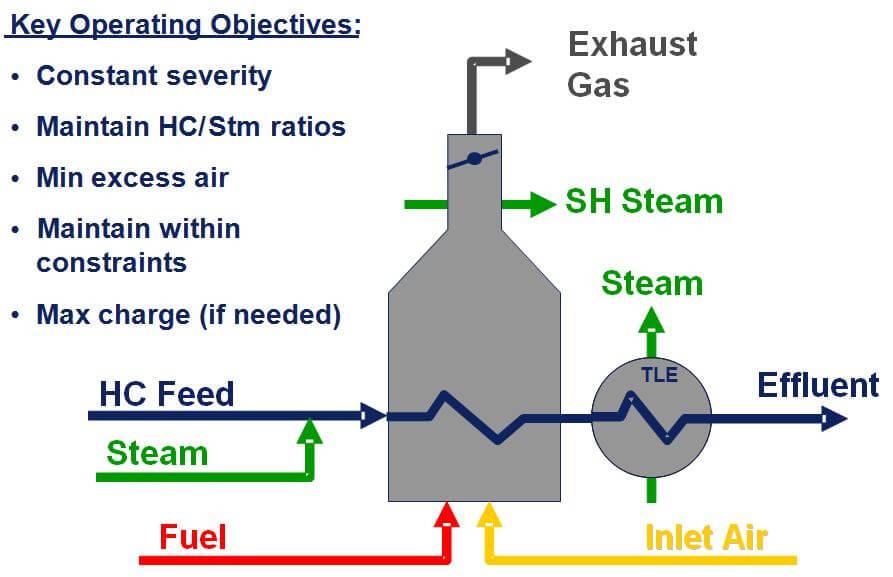A few weeks ago, I relayed a story from Emerson’s James Beall about a process of ongoing plant control performance improvements on which he’s been working with a process manufacturer. He said he had another great story about an ethylene furnace optimization project. Not being the patient sort, I gave it a few weeks and called him yesterday.
For those not familiar with an ethylene (C2H4) production, the production section of the Wikipedia Ethylene page offers:
Ethylene is produced in the petrochemical industry by steam cracking. In this process, gaseous or light liquid hydrocarbons are heated to 750-950 °C, inducing numerous free radical reactions followed by immediate quench to stop these reactions. This process converts large hydrocarbons into smaller ones and introduces unsaturation. Ethylene is separated from the resulting complex mixture by repeated compression and distillation.
The ethylene furnaces provide the heat required for this reaction. James described the key control challenges as maintaining a constant severity target [conversion rate], maximizing the charge or feed rate, maintaining the proper incoming hydrocarbon/steam ratio, minimizing excessive air required in the furnace combustion chamber, and maintaining the furnace within its operating constraints. Given the multivariable nature and the interactions of operating objectives, model predictive control (MPC) was a great fit for this application.
James and the other process control consultants, many featured in this blog’s process optimization category, have created a number of application solutions that combine subject matter expertise, process and advanced process control technology, services and training. These SmartProcess solutions are pre-engineered, have reusable, built-for-purpose templates, and control strategies. The SmartProcess Ethylene Furnace is one example, and the application used in this story.

James shared that the plant operators had to constantly adjust multiple furnace control loop setpoints to maintain the severity target, meet the target feed rate, minimize excess air, maintain equipment constraints, etc. The model predictive controller was ideal for addressing these interactions and setting the key operating objectives. The controlled variables included total charge, combined coil output temperature (COT), stack O2 emission, pass temperature differences, steam ratios, and severity target. The manipulated variables included pass flows, steam ratios, fuel demand, and air demand. Constraints included Oxygent, CO, fuel pressure, air capacity, firebox temperature, draft pressure, crossover tube temperatures, pass outlet temperatures and hydrocarbon feed valve positions. Finally, the disturbances included fuel BTU, heater inlet temperature and feed composition.
The conversion from individual PID loops to MPC took about two weeks per furnace. James noted that improvements learned on the later furnace control conversions were applied back to the earlier MPC controllers. Once the ethylene furnaces were optimized, the team benchmarked the performance and compared it with pre-project performance. They calculated a 70-80% deviation reduction from severity targets and an 87-88% standard deviation reduction in severities resulting in more stable operation. Hot spots in the tubes were reduced 50-90%, which reduced coke buildup which can provide increased run time before decoking.
Average severity increased 3-4% with 7-12 degrees lower COT, and stack O2 levels were reduced 0.23%, which reduced overall energy consumption. Finally, total furnace charge increase 8.4%, which increased the overall capacity.
The payback for the project costs on each furnace was less than 3 months! From the operators’ point of view, the overall performance of the ethylene unit is more stable and the furnaces are capable of running longer between decoking operations. I imagine these results make James a popular person on his visits to the plant!
